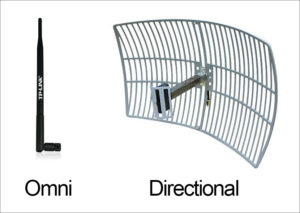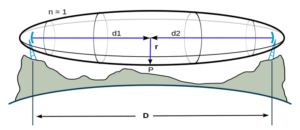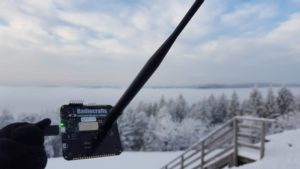Did you know that wireless communication technologies’ range can vary drastically from a 20 cm maximum range with the Near-Field Communications (ex: secure payments using contactless communication) to a staggering 700km range reported for 868 MHz LPRF radio transmitted from a high-altitude weather balloon? (Fun record but not useful other than in a research article) Range in the wireless communication realm is an important and decisive feature when selecting your RF technology. Additionally, there are several major influencing factors that can SIGNIFICANTLY affect your devices range and, therefore, could have detrimental consequences to your business if not understood correctly. On many occasions we have customers coming to us asking the same question:
“Why can’t my module achieve the range advertised on your web?”
In this blog post we will answer that very question with two highly important concepts (Antennas and Line of Sight) which we find our customers struggle with the most and give tips and tricks on how to increase range.
Antenna Choice
A major influencing factor on range which many people have trouble with is selecting the right antenna. Have you ever had an oddly weak wifi connection on your desktop computer at home and you try restarting the wifi router and your computer, but nothing seems to strengthen the signal? Then you notice your wifi card antennas are pointing to the ground instead of towards your wifi router, you fix it, and suddenly your wifi connection strengthens again. Surprisingly, many people are unaware that the antenna even plays a major role in deciding range. There are various things to consider when choosing an antenna, for example, the antenna size, type, and position.
Selecting the right antenna design is crucial. That is why directional antennas can be an ideal option, because they not only provide an increased signal strength and range gains in one direction, but they can also reduce noise interference by simply positioning the antenna so that it does not point towards the interference source. However, be careful not to increase your signal strength so much that you violate local regulatory restrictions for output power. You also want the antenna to be pointing towards the receiver for best results.
Another important factor when considering antennas is the antenna height and position. You want to put your antenna in a high enough position to be above avoidable obstacles. Additionally, if you focus on product design and want a small and hidden antenna inside your product, that will reduce your range. For example, Let’s say that you have an electricity meter which is inside a metal cabinet. That is not an ideal position for an antenna. In a case like this, having an antenna cable and a small antenna on the outside of the metal cabinet will SIGNIFICANTLY increase the range. However, this is less cost effective, so there is a tradeoff here and it is up to the customer to decide what to prioritise for their product.
You can read more about choosing the right antenna in our White Paper – WP008: Antenna Selection Guide.
Line of Sight (LOS)
The Line of Sight range is a THEORETICAL range which is essentially a perfect utopian scenario where you have a clear and open view point between two antennas placed in high locations and there is no other RF noise present in the area. More often than not, Radiocrafts as well as other vendors around the world will advertise the LOS range on the product descriptions. The first mistake many customers make is that they take the LOS range as a REALISTIC target of what they can expect from a real environment.
So why can we not get this LOS range in a real environment?
There are several factors including:
· Obstacles blocking the clear radio path.
· Reflections from objects.
· Diffractions through objects.
· The forces of Mother Nature (rain, snow, and fog).
Line of Sight range, for people who are unfamiliar with the term, can be quite confusing if you take it literally word for word. Here is an example which I am sure will confuse a few people. If you are on the ground and you have a transmitter 100 meters away which is within YOUR line of sight (you can see it in the physical sense), then you still do not have Line of Sight in the RF connection sense because of the ground. Confused? I will explain. This is because when we talk about LOS we need to take free space into consideration. The energy between 2 antennas is not a thin straight line going from one antenna to the other, but rather, a large oval/baguette shaped area of free space. How large is this area of free space? Do not worry, you do not need to place your antennas on the 2 tallest peaks of Mount Everest to have sufficient free space to achieve perfect RF connection. Employing your antennas on two 100-meter-tall towers is theoretically more than enough to give you LOS range.
Radiocrafts did some LOS range measurements for our most recent product line, RIIoT™, and the results were great. Below is a description of the results.
Want to learn more on how to calculate your RF module’s range? Please read our application note, AN021: RF Module Range Calculation and Test.
Case Study, RIIoT
RIIoT range expectations have been confirmed!
RIIoT is the new low power, long range and reliable dense IoT RF network.
It was designed with sufficient range in mind, and we have confirmed it: 15km Line of Sight. And we have still not launched the High Power version that theoretically should improve range by a factor of 5, that should give us 75km!
We measured 100% packet reception with an RSSI value of -99 dBm, which gives us 7dB margin (RSSI is the value of the received signal strength). 7 dB margin means that the distance can be doubled before we get packet losses. 2 times 7.5km is 15 km which was the goal.
See all details of the measurements in application note AN027: RIIoT Range – Basics and Measurement Results here.
What to take away from this?
What you should take away from this blog post is that there are numerous different factors that will affect your range such as choosing the correct antenna type, position, height, and more.
Additionally, when looking for a module with long range, be aware that the range specifications on the datasheet or product description are more than likely a LOS measurement which is a close, but not realistic value on actual range.
What is your interpretation of Line of Sight? Do you have anymore tips to increase range? Do you disagree with one our statements? Use the comment section below to start discussions, ask questions, or just to give feedback and say hi. Radiocrafts or another blog reader will answer!
Do you want to dig deeper into other factors that affect range? Watch the webinar “Expectations and Influencing Factors For Range in RF Networks, Case Study RIIoT”. You can find it in your customer support page. If you are not a registered user, register now to have access to the customer support page.





